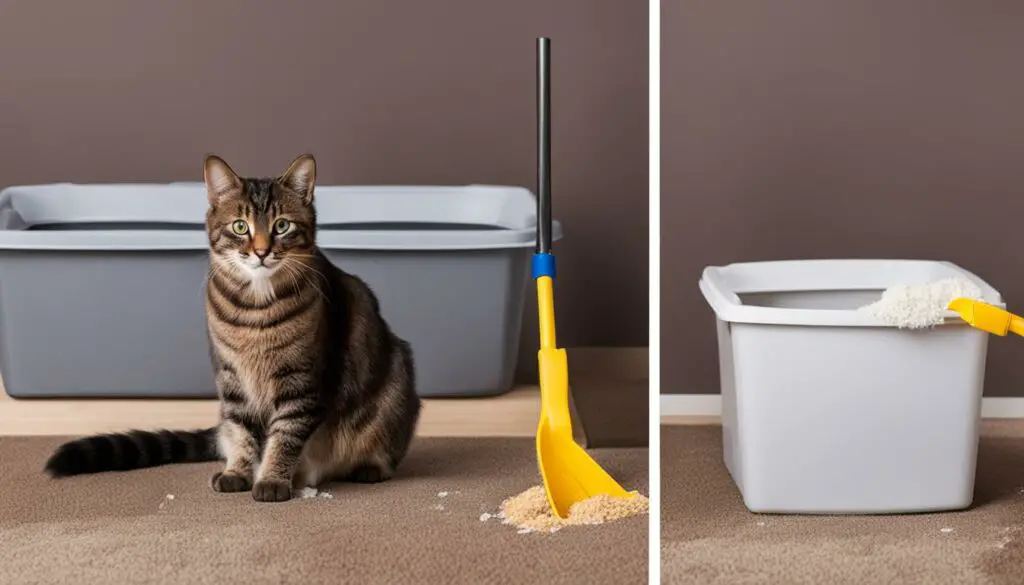Welcome to my comprehensive guide on how to retrain your cat to use the litter box. If you’re facing issues with your feline friend’s litter box habits, don’t worry – you’re not alone! In this article, I will guide you through various retraining techniques and provide valuable insights into understanding cat behavior. By creating a suitable environment and implementing the right strategies, you can successfully help your cat develop proper litter box habits.
Key Takeaways:
- Understand your cat’s natural instincts and provide a suitable litter box environment
- Show your cat how to use the litter box by digging in it with your finger
- Choose a large litter box that matches the size of your cat
- Consider whether a covered or uncovered litter box is preferred
- Have multiple litter boxes and find suitable locations
Choose a large litter box
When it comes to litter boxes, size matters. It’s important to choose a litter box that is large enough to accommodate your cat comfortably. A common mistake that cat owners make is selecting a litter box that is too small for their furry friend. If the litter box is too cramped, your cat may feel uncomfortable and avoid using it altogether.
For growing cats, it’s best to choose a litter box that will accommodate their increasing size. This is especially important if you have a kitten who is still in the early stages of growth. Opt for a litter box with ample room for your cat to move around and assume their preferred posture while eliminating waste.
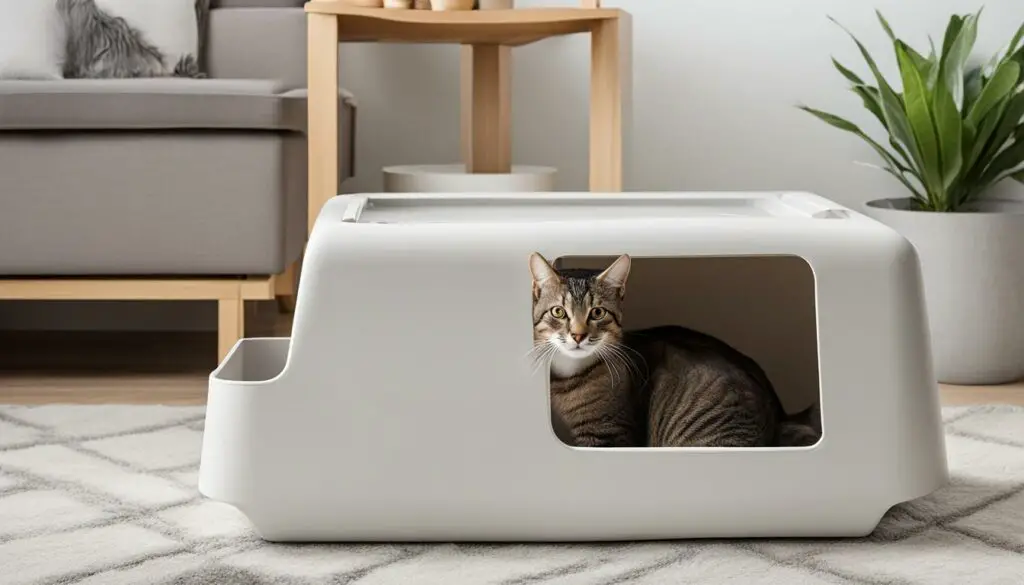
Additionally, if you have a small or elderly cat, consider a litter box with low sides. It can be challenging for cats with limited mobility or smaller stature to climb over high walls. A litter box with low sides makes it easier for your cat to enter and exit the box without any difficulties. By choosing a litter box that suits your cat’s size and needs, you can ensure a positive and comfortable litter box experience for your furry friend.
Decide on Covered or Uncovered
When it comes to choosing a litter box for your cat, one important decision to make is whether to go for a covered or uncovered option. Both types have their own benefits and drawbacks, so it’s important to consider your cat’s preferences when making this choice.
Covered litter boxes offer privacy for your cat, which can be particularly appealing if your cat is shy or easily distracted. The enclosed design also helps contain odors, keeping your home smelling fresh. However, it’s important to note that some cats may find covered litter boxes too confining, especially if they are larger in size. Additionally, the enclosed space can trap smells, making it necessary to clean the litter box more frequently.
On the other hand, uncovered litter boxes provide a more open and spacious environment for your cat. This allows for easier entry and exit, making it suitable for cats of all sizes and ages. Uncovered litter boxes are also typically easier to clean and maintain. However, they do not offer the same level of privacy as covered boxes, which may be a concern for some cats.
Ultimately, the decision between a covered or uncovered litter box should be based on your cat’s preferences. If you’re unsure, you can try both options and observe your cat’s behavior and comfort level. Remember, providing a litter box that suits your cat’s preferences can greatly contribute to successful litter box training.
| Covered Litter Box | Uncovered Litter Box | |
|---|---|---|
| Privacy | High | Low |
| Odor Control | Good | Fair |
| Size Suitability | May be too confining for larger cats | Suitable for cats of all sizes |
| Cleaning Difficulty | May require more frequent cleaning | Easier to clean and maintain |
Remember to consider your cat’s preferences when choosing between a covered or uncovered litter box. Observing their behavior and comfort level can help you make an informed decision. Whether you opt for a covered or uncovered box, the most important thing is to provide a clean and suitable environment for your cat to comfortably use the litter box.
Get more than one box
If you have enough space in your home, it’s beneficial to have more than one litter box. Experts recommend having at least one litter box per cat in the house, plus an additional box. This is especially important if you have multiple cats or a cat that is still learning to use the litter box. Having multiple litter boxes reduces the chances of litter box aversion and provides ample options for your cats to eliminate.
Benefits of multiple litter boxes:
- Reduces competition: Cats are territorial animals and may feel stressed or anxious if they have to share a litter box. Having multiple boxes ensures they have their own space to eliminate.
- Prevents accidents: If one litter box is occupied or not easily accessible, your cats may be more likely to eliminate outside the box. Multiple boxes reduce the chances of accidents happening.
- Encourages cleanliness: Cats are clean animals and prefer to have separate areas for urinating and defecating. Having multiple litter boxes allows them to maintain their cleanliness.
- Convenience for aging cats: Older cats may have mobility issues and find it difficult to reach a single litter box. Having boxes placed strategically around the house ensures they can easily access a litter box.
When setting up multiple litter boxes, make sure they are placed in different areas of your home, ensuring each cat has easy access to a box. Additionally, regularly clean and maintain each box to promote good hygiene and prevent any aversion to using the litter box.
By providing multiple litter boxes, you create a positive environment that encourages your cats to use the box and reduces the likelihood of accidents or litter box aversion. Remember, each cat is unique, so observe their behavior and preferences to ensure they have a comfortable experience using the litter box.
Find a Good Location
When it comes to litter box training, choosing the right location is crucial for encouraging your cat to use it. You want to select a spot that is easily accessible and convenient for your furry friend. Avoid placing the litter box near your cat’s food and water as they prefer to eliminate away from those areas. Instead, provide a quiet and low-traffic spot for the litter box to ensure your cat feels comfortable and undisturbed.
By placing the litter box in a location that is easily accessible from most areas of your home, you eliminate the need for your cat to search for the litter box when they need to relieve themselves. This can help prevent accidents and ensure that your cat can quickly and easily find the litter box when they need it.
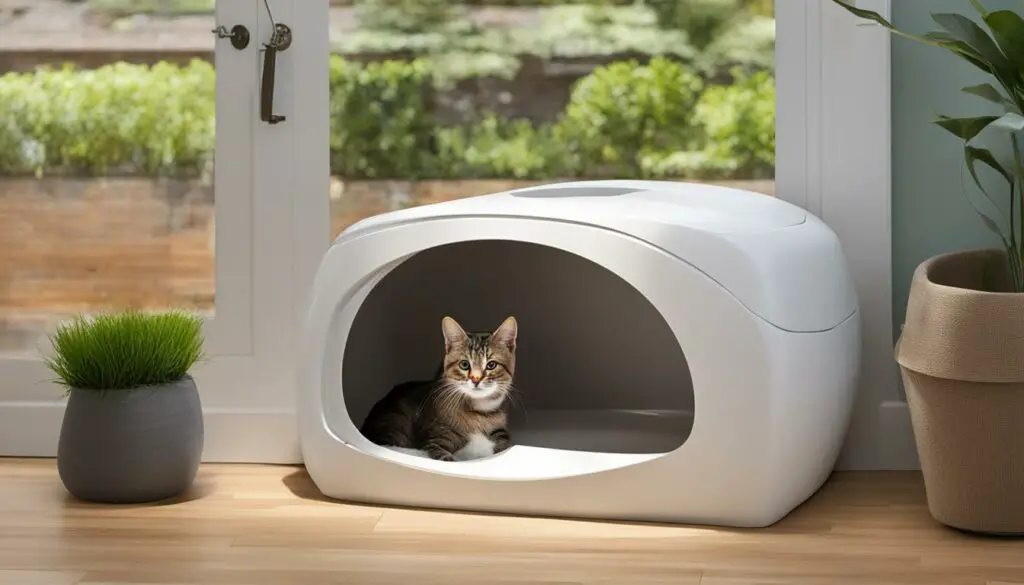
Remember, every cat is different, and preferences can vary. Some cats prefer a more private area for their litter box, while others may be more comfortable with a litter box that is in a busier or more social part of the home. Observe your cat’s behavior and preferences to determine the best location for their litter box.
Choose the right litter
When it comes to choosing the right litter for your cat, there are a few factors to consider. Cats generally prefer clumping litter as it provides a comfortable texture for them to walk on and makes it easier for them to bury their waste. Opt for unscented litter as added perfumes or deodorizers may irritate your cat’s sensitive nose or trigger allergic reactions.
It’s also important to note that clay litter should be avoided, especially for kittens, as it can be harmful if consumed. Instead, look for natural litter options that are safe for your furry friend. By selecting the appropriate litter, you can ensure your cat is comfortable using the litter box, which is essential for successful litter training.
“Cats generally prefer clumping litter as it provides a comfortable texture for them to walk on and makes it easier for them to bury their waste.”
Remember that every cat is unique, so it may take some trial and error to find the litter that your cat prefers. You can start by introducing a small amount of different litters and observing your cat’s response. Pay attention to their behavior and use their litter box preferences as a guide in choosing the right litter for them.
| Litter Type | Pros | Cons |
|---|---|---|
| Clumping Litter | Easy to clean, minimizes odor | Can be more expensive |
| Non-Clumping Litter | Less expensive | May require more frequent cleaning |
| Wood or Paper Pellet Litter | Natural and biodegradable | May not control odor as effectively |
| Silica Gel Litter | Excellent odor control | Can be dusty |
Remember to provide continuous access to fresh litter in the litter box and regularly scoop out any clumped waste to maintain cleanliness. By choosing the right litter for your cat, you can create a comfortable and inviting environment that encourages them to use the litter box consistently.
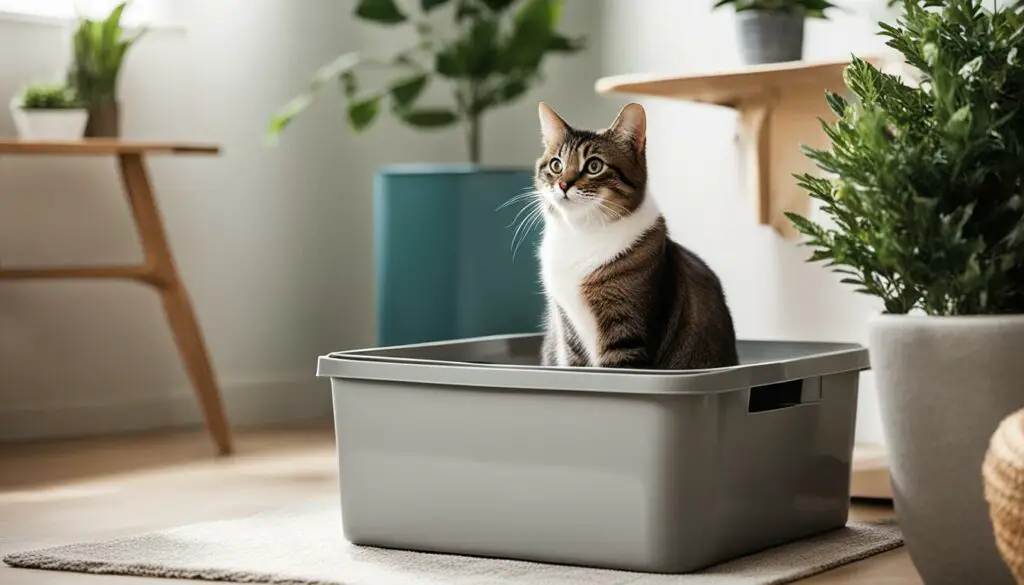
Use the right amount of litter
When it comes to litter box training, the amount of litter you use plays a crucial role in your cat’s comfort and success. Start by filling the litter box with about two inches of litter, ensuring a sufficient depth for your cat to dig and cover their waste. Observe your cat’s satisfaction with this depth, and if they seem unsatisfied, you can gradually increase the litter depth to around four inches.
Regularly scooping out solid and clumped wastes is essential to maintain cleanliness and encourage your cat to use the litter box. Some experts recommend scooping at least twice a day, ensuring that the litter box is consistently fresh and inviting for your cat. By regularly scooping, you prevent odors and maintain a hygienic environment for your furry friend.
Additionally, it’s important to thoroughly wash the litter box at least once a week. Use warm water and a gentle soap to clean the box, removing any lingering odors and maintaining a clean surface for your cat’s use. After washing, refill the litter box with fresh, clean litter to the desired depth.
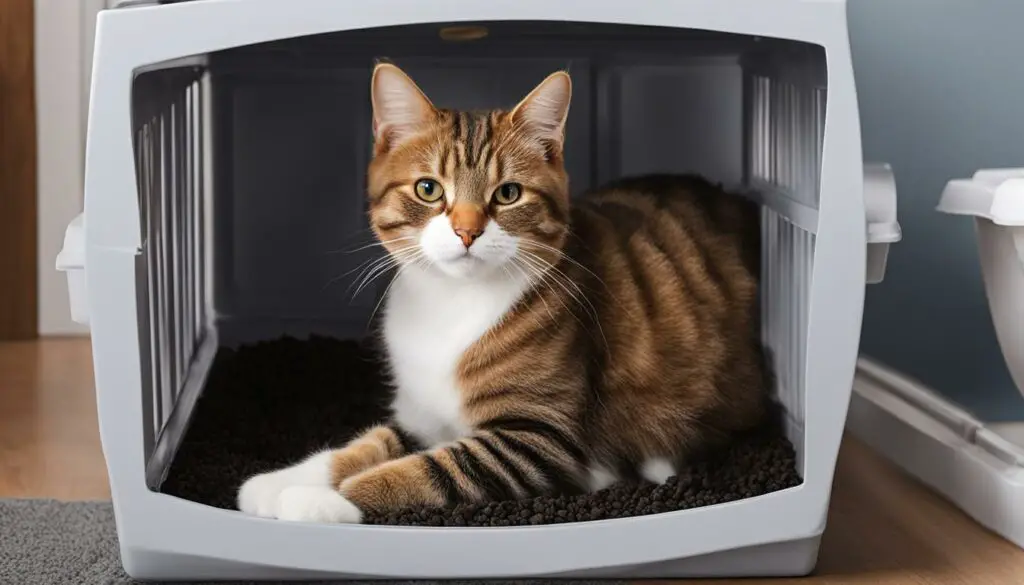
Benefits of Using the Right Amount of Litter
Ensuring the right amount of litter in the box offers several benefits for both you and your cat. Here are some advantages of using the correct litter quantity:
- Comfort: Adequate litter depth allows your cat to dig and cover their waste easily, mimicking their natural instincts.
- Prevent tracking: With the right amount of litter, you can minimize litter tracking around the house, keeping your living area cleaner and tidier.
- Reduced odors: Proper litter depth helps absorb and control odors, providing a fresher and more pleasant environment for both you and your cat.
- Encourages regular use: Cats are more likely to use a litter box that is maintained at the right litter depth, promoting consistent and appropriate elimination behavior.
Table: Comparing Litter Depth Recommendations
| Litter Depth (in inches) | Advantages | Disadvantages |
|---|---|---|
| 2 inches | – Suitable for most cats – Easy to dig and cover waste – Less litter consumption |
– May be insufficient for larger cats or those with strong digging tendencies |
| 4 inches | – Accommodates larger cats – Provides ample depth for digging and covering – Reduces litter tracking |
– Requires more litter – May be excessive for small or elderly cats |
Keep a clean litter box
Maintaining a clean litter box is essential for cats to continue using it. Regular cleaning not only ensures your cat’s comfort but also promotes good hygiene and minimizes odors in your home. Here are some important tips to keep your cat’s litter box clean:
- Establish a cleaning schedule: Set a routine for scooping out solid wastes and clumped-liquid wastes from the litter box. Daily cleaning is recommended to maintain cleanliness and prevent your cat from refusing to use a dirty litter box.
- Remove solid wastes: Use a scooper to remove solid wastes from the litter box. Dispose of them in a sealed bag or trash can to prevent unwanted odors.
- Clear clumped-liquid wastes: Break apart any clumps in the litter box using the scooper. Dispose of the clumps in the trash, making sure to maintain the desired litter depth.
- Do a full wash: Once a week, it’s important to do a full wash of the litter box. Use warm water and a mild soap to thoroughly clean and disinfect the box. Rinse it well to remove any soap residue, then allow it to dry completely before refilling with clean litter.
By following a consistent cleaning routine, you can ensure that your cat always has a clean and inviting litter box to use. This will help maintain their litter box habits and prevent any aversions or accidents outside the box.
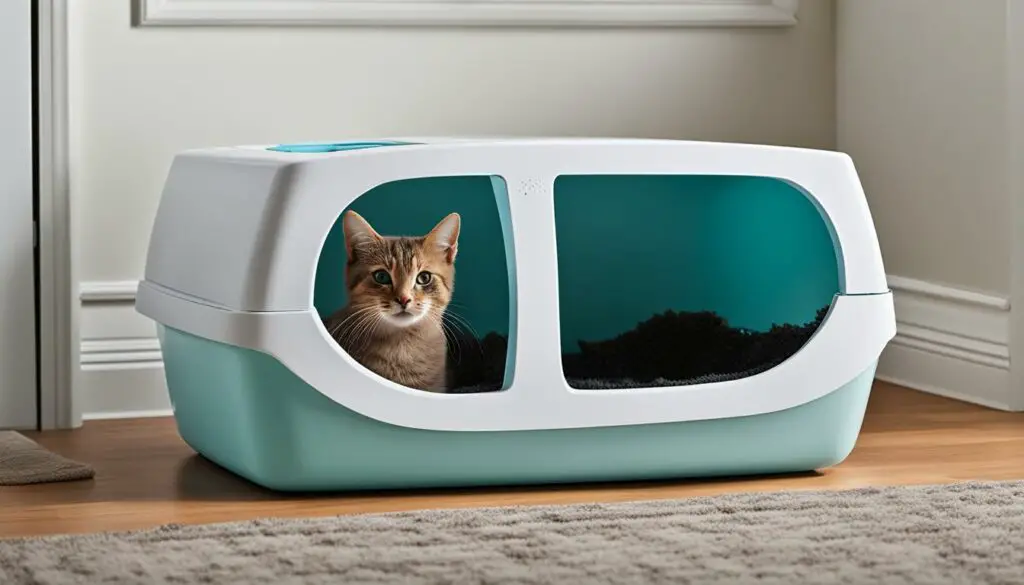
| Cleaning Task | Frequency |
|---|---|
| Scooping out solid wastes | Daily |
| Clearing clumped-liquid wastes | Daily |
| Full wash with warm water and mild soap | Once a week |
Learn your cat’s schedule
Understanding your cat’s elimination schedule is crucial in guiding them to use the litter box at the right times. Cats tend to have predictable patterns when it comes to relieving themselves, and recognizing these patterns can help you redirect them to the litter box instead of finding alternative places.
Cats often need to eliminate after naps, playtime, or mealtime. These activities stimulate their digestive system and create the urge to use the litter box. By observing your cat’s behavior and noting the times they typically engage in these activities, you can proactively guide them to the litter box during these moments.
For example, if you notice that your cat often takes a nap after their meal, make sure to gently carry them to the litter box when they wake up. By consistently reinforcing this routine, they will associate the litter box with their elimination needs and develop the habit of using it regularly.
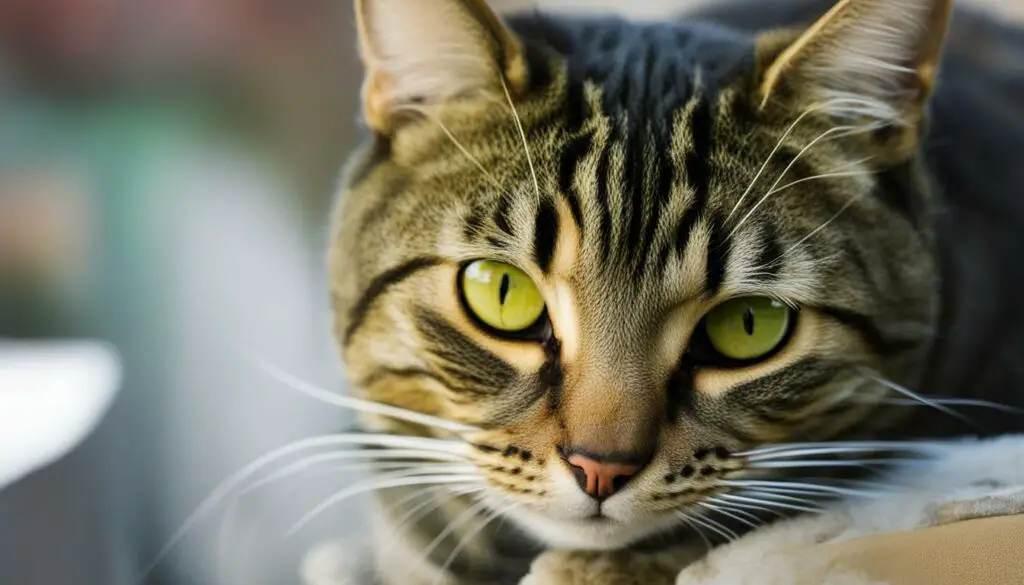
“Understanding your cat’s elimination schedule is crucial in guiding them to use the litter box at the right times.”
Play with your cat near the box
Playing with your cat near the litter box can greatly facilitate the elimination process. Engaging in interactive play sessions can stimulate your cat’s need to eliminate. By being near the litter box during these playtimes, you can guide your cat to the appropriate location when they need to relieve themselves. Consider closing the door to the room with the litter box during playtime to ensure your cat doesn’t wander too far.
Playtime near the litter box serves as a reminder for your cat to associate the litter box with the elimination process. This helps them develop a habit of using the litter box consistently. It’s important to create positive experiences during playtime and reward your cat with praise or treats when they use the litter box afterwards.
It’s worth noting that cats naturally prefer to eliminate in areas where they feel secure and undisturbed. By playing near the litter box, you create a comfortable and familiar environment for your cat to relieve themselves. This can reduce anxiety or stress-related accidents and encourage better litter box habits.
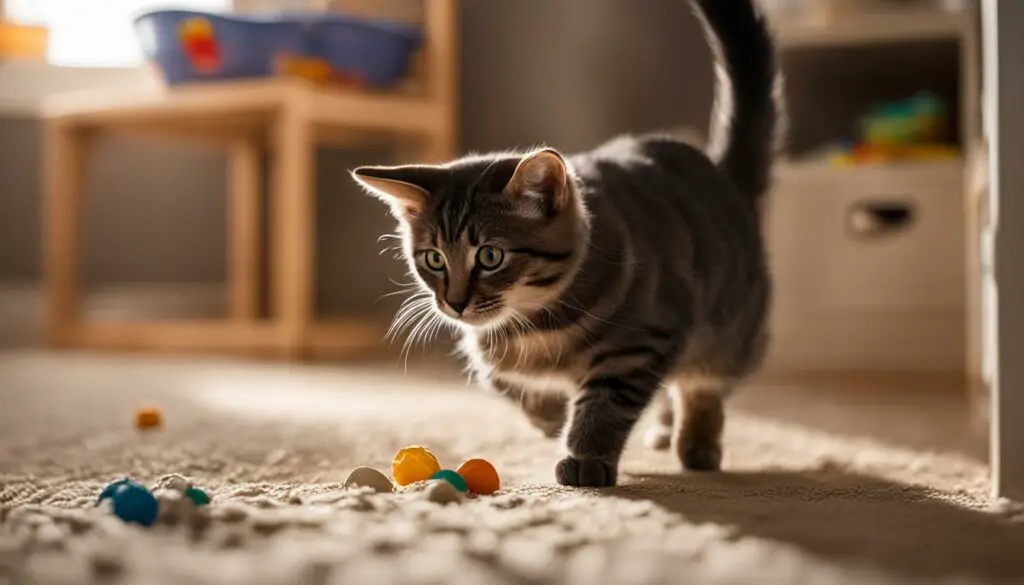
Benefits of playing near the litter box
- Facilitates the association between playtime and using the litter box.
- Reduces the chances of accidents and inappropriate elimination.
- Creates a comfortable and secure environment for your cat to eliminate.
- Helps establish a routine and consistent litter box usage.
Teach them what to do
When it comes to retraining a cat to use the litter box, it may be necessary to show them how it’s done. Use your finger to demonstrate the digging behavior by scraping aside some litter. This tactile stimulation can help them understand what the litter box is for.
If your cat eliminates in the box but doesn’t bury it, you can use your finger to scoop a little litter on top of their waste. This mimics the natural instinct of burying their waste and can encourage them to do the same in the future.
Patience and consistency are key when teaching your cat these litter box behaviors. Rather than grabbing their paw, it’s best to guide them with your own finger. This gentle approach can help build a positive association with the litter box and increase their chances of successfully using it.
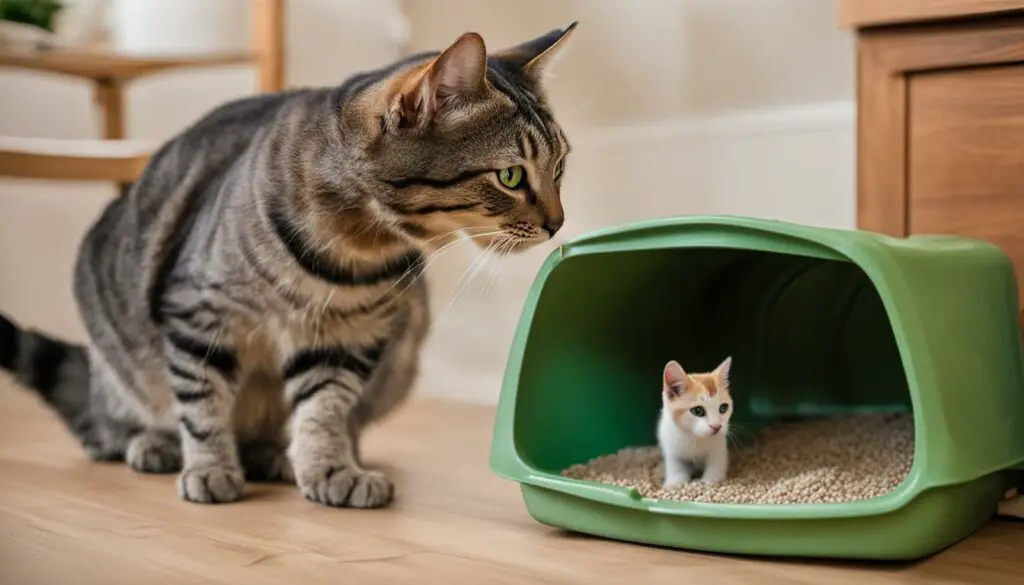
Teaching Tips:
- Show your cat how to dig in the litter box by gently scraping aside the litter with your finger.
- If your cat eliminates in the box but doesn’t bury it, use your finger to scoop a little litter on top.
- Be patient and consistent in teaching your cat these behaviors, using your own finger instead of grabbing their paw.
Quote:
By gently demonstrating the digging behavior with your finger, you can help your cat understand the purpose of the litter box.
Table: Comparison of Teaching Techniques
| Technique | Advantages | Disadvantages |
|---|---|---|
| Using your finger to show digging behavior | Provides tactile stimulation and mimics natural instincts | Requires patience and consistency |
| Grabbing the cat’s paw | Can be quicker for some cats to understand | May cause stress or discomfort |
| Using litter attractants | Can further encourage litter box use | Additional cost and reliance on external products |
The Litter-Training Low-Down
When it comes to litter training, it’s important to understand that young kittens may need manual stimulation to pee and poop until they are around 3 weeks old. During this exploration period, they will naturally start to explore their environment, including the litter box. This is because cats have an innate behavior of eliminating in something sandy, which is inherited from their wild relatives. By creating a positive association with the litter box, you can help your kitten develop good litter box habits.
As kittens grow older, it’s crucial to be patient and persistent during the training process. Provide a suitable litter box environment by choosing the right litter box, litter type, and location. Ensure the litter box is easily accessible and away from their food and water. Cats have natural instincts to eliminate away from where they eat. Additionally, keep the litter box clean by regularly scooping out solid and clumped-liquid wastes. This will encourage your cat to continue using the litter box.
While it’s normal for cats to have occasional accidents during the training process, monitoring their behavior is essential. If your cat repeatedly eliminates outside the litter box, it may indicate an underlying medical issue that requires veterinary attention. Keeping a journal of mistakes can provide valuable insight for your veterinarian in resolving litter box issues. Remember, each cat is unique, and it may take time to find the right approaches for your cat’s litter training needs. With consistency and dedication, your furry friend will be back on track using the litter box.
| Keyword | Definition |
|---|---|
| Manual stimulation for young kittens | The act of gently stimulating a kitten’s elimination process by mimicking their mother’s grooming behavior. |
| Exploration period | A phase in a kitten’s development when they start to explore their environment and develop associations with certain behaviors, such as using the litter box. |
| Natural instincts | Innate behaviors that cats inherit from their wild relatives, such as eliminating in something sandy. |
| Litter box association | The positive connection a cat develops with the litter box, associating it with the act of elimination. |
Everything you need to litter train a cat
When it comes to litter training a cat, having the right supplies is essential for success. Here’s a breakdown of the key items you’ll need:
- A suitable litter box: Choose a box that is large enough for your cat to comfortably move around in. Consider using a low-sided box or a puppy pan if your cat has trouble getting in and out of a standard litter box.
- The right litter: Opt for a natural, unscented litter that mimics sandy textures. Cats prefer the feel of fine-grained litter, making it more likely that they will use the litter box.
- Multiple litter boxes: If you have multiple cats, follow the rule of one litter box per cat plus an extra box. This ensures that each cat has ample options for eliminating and reduces the chances of litter box aversion.
These supplies provide the foundation for successful litter training and create an environment that encourages your cat to use the litter box. Additionally, you may want to consider using a litter mat to catch any stray litter and make cleanup easier.
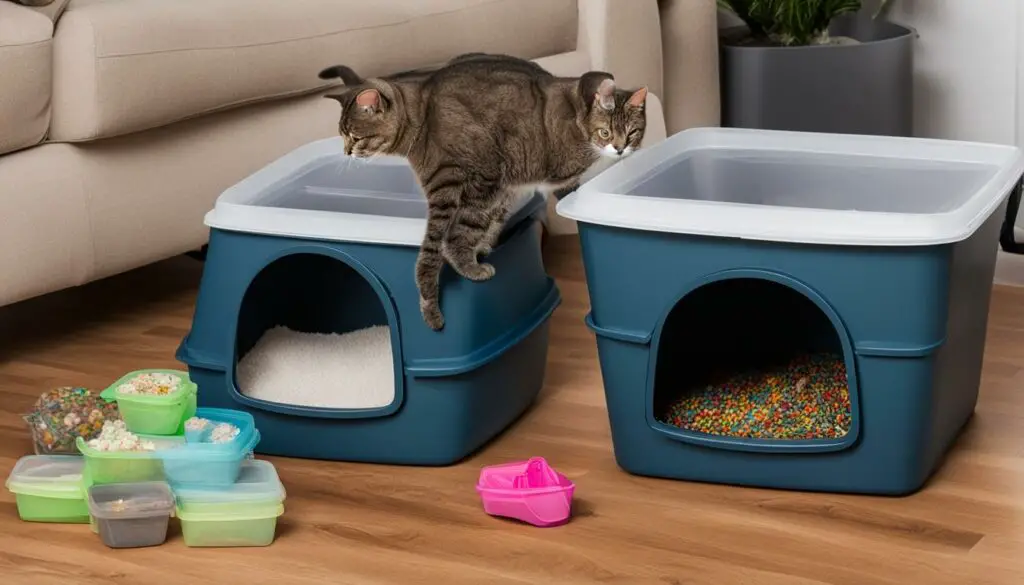
By providing the right supplies and creating a suitable litter box environment, you can set your cat up for litter box training success.
Now that you have the necessary supplies, it’s time to learn how to properly litter train your cat. In the next section, we will outline the step-by-step process to guide your feline friend towards successful litter box usage.
How to Litter Train a Cat
Litter training a cat can sometimes be challenging, but with the right approach and understanding of your cat’s behavior, it can be successfully accomplished. Here are the essential steps to help you litter train your cat:
- Choose the correct litter box: Select a litter box that is suitable for your cat’s size and needs. Consider a larger litter box for bigger cats or those that are still growing, and opt for a low-sided box for small or elderly cats.
- Find the perfect litter: Use a natural, unscented litter with a fine-grained texture that mimics sandy surfaces. This type of litter is generally preferred by cats and encourages them to use the litter box.
- Location, location, location: Place the litter box in a quiet and easily accessible area of your home. Avoid placing it near your cat’s food and water bowls, as cats prefer to eliminate away from those areas.
- Keep it clean: Regularly scoop out solid and clumped wastes from the litter box to maintain cleanliness. Consider scooping at least twice a day and doing a full wash of the litter box once a week using warm water and a mild soap.
Remember to be patient and persistent during the training process. Each cat is unique, and it may take some time for them to fully grasp the concept of using the litter box. Providing a suitable environment, choosing the right litter, maintaining cleanliness, and being consistent in your training efforts will help your furry friend learn to use the litter box effectively.

Tips for Successful Litter Training
- Use positive reinforcement: Reward your cat with treats or praise when they use the litter box correctly. This helps reinforce the desired behavior and encourages them to continue using the litter box.
- Monitor your cat’s behavior: Keep an eye on your cat’s elimination schedule and promptly redirect them to the litter box after naps, playtime, or mealtime. This helps establish a routine and reinforces the association between the litter box and eliminating.
- Address any issues promptly: If your cat repeatedly eliminates outside the litter box, it may indicate an underlying medical issue or a problem with the litter box itself. Consult with your veterinarian to rule out any medical conditions and make necessary adjustments to the litter box setup.
By following these steps and incorporating these tips, you can effectively litter train your cat and create a clean and hygienic environment for both you and your feline companion.
Cat litter box training problems
When it comes to litter box training, it’s important to monitor your cat’s behavior to ensure they are using the box correctly. If you notice your cat repeatedly eliminating outside of the litter box, it may indicate an underlying medical issue that requires attention from a veterinarian. It’s important to rule out any health-related problems before addressing behavioral or training issues.
Another factor to consider is the cleanliness of the litter box. Cats are clean animals, and they may be deterred from using a dirty litter box. Make sure to adhere to a consistent cleaning schedule by scooping out solid wastes regularly and doing a full wash of the box at least once a week. This will help maintain cleanliness and encourage your cat to use the litter box.
Litter box accessibility is also crucial. Ensure that the litter box is easily accessible for your cat, especially if they are elderly or have mobility issues. If the sides of the litter box are too high, your cat may have difficulty getting in and out, leading to accidents outside of the box. Consider using a low-sided litter box or a puppy pan to accommodate their needs.
Finally, take into account your cat’s litter preferences. Cats have individual preferences when it comes to litter texture and scent. Experiment with different types of litter to see which one your cat prefers. It’s recommended to use a natural, unscented litter that mimics sandy textures. By addressing these potential issues and finding the right solutions, you can overcome litter box training problems and ensure a successful training process.
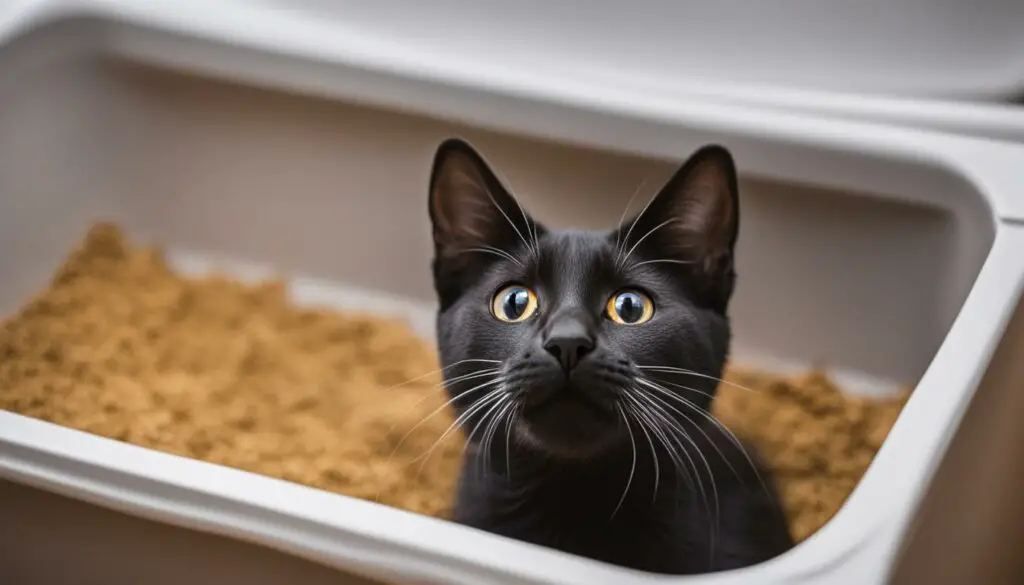
| Problem | Possible Solution |
|---|---|
| Eliminating outside the litter box | Check for underlying medical issues and consult a veterinarian |
| Dirty litter box | Adhere to a consistent cleaning schedule by scooping regularly and doing a full wash at least once a week |
| Inaccessible litter box | Ensure the litter box is easily accessible, especially for elderly or mobility-impaired cats. Consider using a low-sided box or a puppy pan |
| Unsuitable litter | Experiment with different types of litter to find the one that your cat prefers. Opt for a natural, unscented litter with a sandy texture |
Conclusion
Litter box retraining can be a challenging process for cat owners, but with the right techniques and understanding of your cat’s behavior, it can be successfully accomplished. By providing a suitable litter box environment, choosing the right litter, maintaining cleanliness, and being patient and persistent, you can set your furry friend up for successful litter training.
Remember that each cat is unique, and it may take time to find the right approaches for your cat’s litter training needs. Consistency and dedication are key. Monitor your cat’s behavior closely, and if they repeatedly eliminate outside the litter box, it may indicate an underlying medical issue that requires veterinary attention.
Keep in mind that the litter box is a vital part of your cat’s life, and it’s important to create a positive association. By understanding their schedule, playing near the litter box, and teaching them proper digging behavior, you can help them develop good litter box habits.
With time and effort, your cat will learn to use the litter box consistently. Remember to be patient, observe their preferences, and make adjustments as needed. Successful litter training is possible, and it will lead to a happier and healthier environment for both you and your feline companion.
FAQ
How many litter boxes should I have for my cat?
It is recommended to have at least one litter box per cat in the house, plus an additional box.
What is the best location for the litter box?
Choose a location that is easily accessible from most areas of your home, away from the cat’s food and water.
Should I choose a covered or uncovered litter box?
The decision depends on the preferences of your cat. Covered litter boxes offer privacy but can trap odors and may be too small for larger cats. Uncovered litter boxes are generally recommended for multi-cat households.
What type of litter should I use?
Cats generally prefer clumping litter that is unscented. Avoid using clay litter, especially for kittens.
How much litter should I put in the litter box?
Start with about two inches of litter and adjust depending on your cat’s satisfaction. Regularly scoop out solid and clumped waste to maintain cleanliness.
How often should I clean the litter box?
It’s recommended to scoop out solid and clumped-liquid waste daily and do a full wash of the litter box once a week using warm water and mild soap.
What is the best way to teach my cat to use the litter box?
Show your cat how to use the litter box by digging in it with your finger. Be patient and consistent in teaching your cat these behaviors.
Do kittens need special litter training?
Yes, young kittens may need manual stimulation to pee and poop until they are around 3 weeks old. After that, they will naturally develop an association with the litter box.
What supplies do I need for litter training?
You will need a litter box, cat litter, and possibly a litter mat to catch any stray litter. Consider a low-sided box or a puppy pan for kittens or cats that have trouble getting in and out of the litter box.
What if my cat keeps eliminating outside the litter box?
If your cat repeatedly eliminates outside the litter box, it may indicate an underlying medical issue. Double-check your cleaning schedule and ensure the litter box is easily accessible for your cat.

